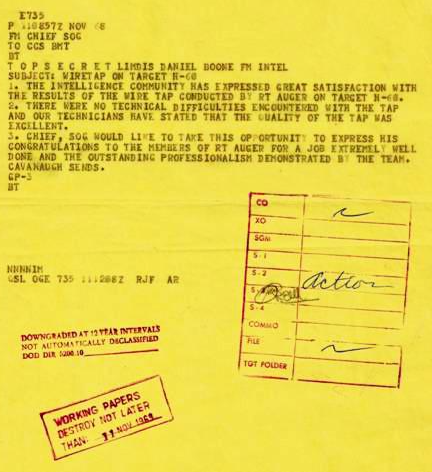Interviewed by: Peter Lloyd
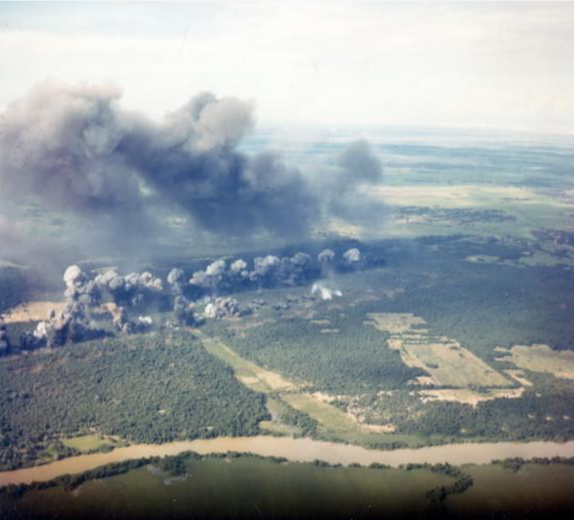
A B-52 strike during the Vietnam War.
PAL: Jim, in your book No Guts, No Glory you recount a wiretap mission inside Cambodia in September 1968. Can you describe that mission?
JB: First I would like to make a statement about my two most successful missions, this wire tap and another, earlier, mission destroying the largest weapons cache ever found in a classified area (which we’ll feature in a separate interview). Both these missions saved possibly thousands of American lives (this was told to me by Chief SOG) and my most gratifying. The strangest thing about both these operations, being highly dangerous and against tremendous
odds, was that there wasn’t a single hostile shot fired by either side.
Members of RT Auger (L to R) Me, Nay Bunn, Mang Koah and Sgt Bari Knowles
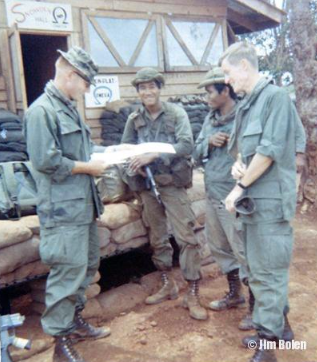
The wiretap mission had started out as a standard reconnaissance mission. After moving through the jungle, which had heavy foliage, for the better part of the day, we came across a six to eight foot-wide, high-speed well used trail. Right away we knew we were in an area full of the enemy because you very seldom come across a trail this big and well used. After watching the trail for a short time, for enemy movement, we carefully crossed into the jungle on the other side and discovered another smaller trail, about twenty feet away, which was three feet wide and contained a communication wire. Finding a communication wire in enemy territory was like winning the lottery. We continued on for about twenty feet in the same direction and came across another high-speed trail, same size as the first. That told me there was a very high concentration of NVA around, and now the mission had changed from reconnaissance to wiretap.
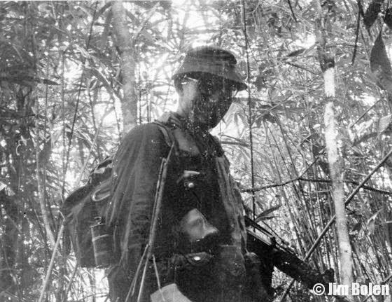
Jim on a SOG mission inside the Cambodian jungle.
PAL: What did you do next?
JB: Now we had some decisions to make. We were standing in between two large and heavily used enemy trails about forty feet apart with a two or three foot wide communication trail running in between them. Our six man team was vulnerable and too hard to hide where we were. Not knowing what was ahead of us I made the decision it would be safer to return the way we came in and to get as far away from this hot spot as possible. Luckily we were not compromised and moved back well away from the hot area. It was getting late and we found a good concealed place to RON (remain over night). I contacted our FAC (Forward Air Controller) and explained our findings. I requested wiretap equipment ASAP, and within less than an hour our Command Center radioed back and said they’d have one for us first thing the next morning.
A Forward Air Controller over the jungle
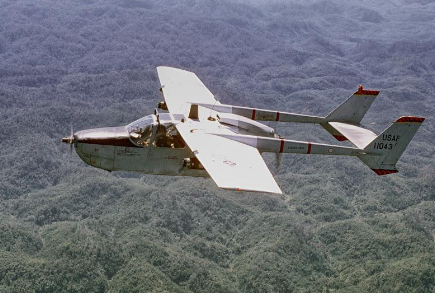
PAL: How did you spend that night waiting for the equipment?
JB: That evening, before dark, I explained to Sgt Knowles and the rest of my team what I thought would be the best way to approach our new mission. There were a lot of ‘if’s’. First, we had to make it through the night in this heavily occupied part of jungle. Second, we had to find a place to pick up the wire tap device the next morning without being compromised. Third, I hoped the device would be one that we were familiar with. Fourth, we had to get back to the wire area without being spotted. Fifth, if all that went well and we got to the wire, we hoped the wire was active (being used by the enemy and not just an old wire left in place). The following morning we found a LZ (landing zone) close by, which was in shoulder-high elephant grass.
We were contacted by the FAC and he said he was in our area. By using a mirror he found our exact location and guided the chopper in with the device. The chopper hovered about four feet off the ground and dropped the equipment to me and flew away. We moved a short distance from the LZ and listened for an hour or so to see if we attracted any attention before moving back to the wire site. We examined the device and found it to be a 4-114A surveillance type of recorder with 2 headsets, batteries and cassette tapes. It uses a “hard tap” which means it had to be attached to the wire, not the more sophisticated “proximity” type. It is attached by a small “clip-on” which does not leave any marks on the wire.
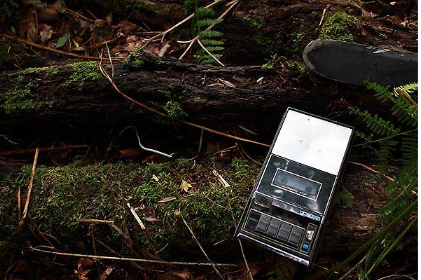
This is not the exact device but is very similar
PAL: Did you have previous training in using these devices?
JB: We were familiar with this type of device; it is very easy to use.
PAL: What did you do after receiving the wire tap?
JB: Once I felt it was safe to move, we headed back to the communications site. As we had discussed the night before, what I thought would be the safest way to deploy the team because of the very limited concealment area, was to break up into two units. I just took my interpreter, Nay Bunn, with me to help monitor the wire (because of the language barrier), and left Sgt. Knowles and the balance of my team in a safer area. I took the radio, because of our more exposed position and so I could directly communicate with the FAC. Then Nay Bunn and I crossed the first high-speed trail and reached the wire. We found a heavily vegetated area next to the wire and hooked up the equipment and moved back to the concealed position between the wiretap and high speed trail.
PAL: What kind of distance away from the high-speed trail were you when you were concealed?
JB: Nay Bunn and I were lying about 3 to 4 feet from the wire trail and 16 to 18 feet from the first high speed trail. I wanted to be close enough from the wire trail so I could reach out and connect or disconnect the wire tap device without much movement when necessary.
PAL: What happened once you were in place?
JB: We both had headsets and almost immediately we began picking up enemy communications on the wire. My interpreter translated the messages for me. When I told the FAC we were picking up traffic, and he relayed it to our Command Center, we were later told they all started dancing in celebration singing “the box is talking”, “the box is talking”. Again, it was one-in-a-million chance to find a wire. Then to find it active and to actually be able to listen and record communications on it was unbelievable.
PAL: What happened next?
JB: All the chatter on the wire was North Vietnamese, so Nay Bunn kept me informed what was going on and if it was important. Then we spent the next two days and nights lying prone, switching on the equipment at the slightest sound,
and turning it off whenever the line went quiet to conserve battery life and cassettes.
PAL: How did you do that?
JB: The wire tap piece of equipment had a long lead from the enemy wire point of contact so the equipment was with me 24/7 for control.
A modern-day photograph of the Sihanouk Trail in Cambodia, similar to where the wiretap mission took place
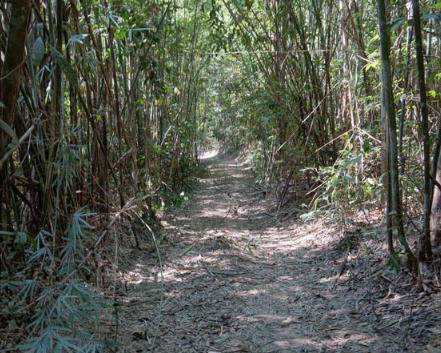
PAL: What about soldiers on the foot trails – were the trails busy?
JB: There was heavy enemy foot traffic on both high-speed trails the entire time we were there. We had no idea until later that we were in between two NVA Regimental base camps (each Regiment has 1500-3000 men).
PAL: How close were you to the passing soldiers? Could you see the whites of their eyes? Hear them talk?
JB: The soldiers on the main trail were 15 to 18 feet away from us, still too close, and we could hear their conversations easily. From our vantage point, lying down, we could not see them very well. From the best as I can remember they were moving in groups of 6 to 10 but not in regular formations. They were not the ones we were worried about. It was standard procedure in all Armies around the world that when you have a communication wire, it is inspected periodically day and night. The idea of inspection was to be sure that there was nothing attached on the wire by an enemy force. This was done with one or two soldiers walking down the wire trail either with a stick device that has a loop on the end or by running the wire through their hand. This was the way they checked for wire taps. Under normal conditions we would have been compromised with the enemy using this application. Luckily for us, for some reason the two Regiments would radio each other and say they were sending a small squad to inspect the wire. Nay Bunn would tell me they were coming, so I would crawl out and disconnect the clip-on device from the wire. Once they passed me and got out of sight I would reach out again and replace the clip-on. I just could not believe the enemy would be this sloppy.
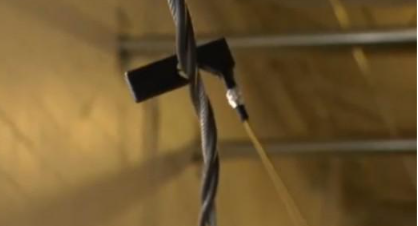
MACV-SOG Wire Tap
PAL: How close were the teams checking the wire from your concealed position?
JB: I could very easily reach out and trip them if I wanted to.
PAL: What was going through your mind for the two days you were out there? Excitement? Fear of discovery?
JB: There was a multitude of things going through my mind. I was worried about Sgt. Knowles and if he and the balance of my team were OK. I was concerned about Nay Bunn, my very good friend, and of course the hair on the back of my head was standing at attention the entire time. I was wondering about what we were getting on the tapes: Not being able to understand what was being said, I was hoping it would be useful intelligence. Overall I had a real feeling of accomplishment, doing something that had not been done before by any one at my unit or in SOG that I knew or had heard of. Then of course I was thinking how the hell we were going to get out of therewith the tapes.
NVA Soldiers with AK-47s
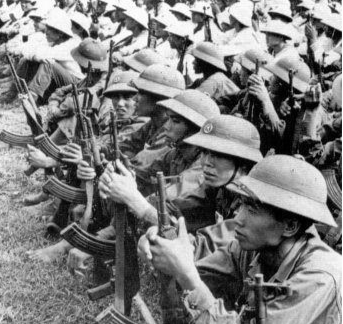
PAL: Did you never need to pee or crap out there over the course of the time you spent concealed? How did you deal with that?
JB: There was no solid food being consumed, only water. Peeing was done in place lying on your side. We had a very special pill kit that would give us what we needed. This is why we did not need to sleep much, eat or use the restroom facilities to any degree.
PAL:How many days did you spend in place, monitoring the communications?
JB: After two days of surveillance I was contacted by the FAC to prepare to be extracted. I think the powers-that-be thought we had taken enough of a risk and they really wanted those tapes. I think this was the scariest part for me. We moved back and met up with Sgt Knowles and the team. We made our way to the LZ where we picked up the wire tap device originally. That seemed to be the safest area, that is why we chose it, and we were extracted without incident.
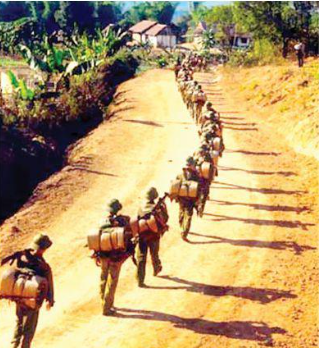
North Vietnamese soldiers head to the Ho Chi Minh Trail for a long march south.
PAL: Did you ever find out how valuable the wire tap had been?
JB: It was valuable in two ways. Firstly, it told us there were two Regiments of enemy soldiers that intelligence was not sure were there. Secondly, and most importantly, we discovered there was a military Battle Plan in place for an attack on one of our Military bases, including times and place. When Nay Bunn and I were listening we could hear faint background noises. I did not know what it was, it just sounded like people whispering in the background, but I taped it anyway. This went on both days. I thought it was probably garbage but did not want to take any chances and miss something. Taping their conversations was easy. Well I found out that the “background noises” were meetings of the North Vietnamese Officers that were commanding
the Regiments. Apparently the communications system being used by the NVA was not very sophisticated. The microphone handsets had no on or off buttons, so they were transmitting all the time. What I captured with the “background” noise was the Regimental Commanders planning an attack on our bases in Pleiku.
Our tapes were immediately sent to the CIA in Saigon, and, using high tech equipment, they cleaned up the tapes and retrieved information from the background noise about when and what time the NVA were going to cross the border into South Vietnam to launch their intended surprise attack on one of our bases.
Part of Camp Holloway, Pleiku, a possible target of the thwarted attack.
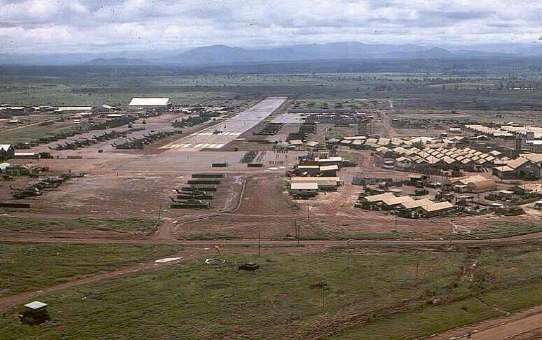
PAL: Do you know what happened after the tapes were translated?
JB: I was told the NVA regiments were hit by B-52 strikes at the border, and that my wiretap had saved hundreds and hundreds of American lives. Chief SOG, Colonel Cavanaugh, said this one wiretap mission had justified the entire seven years of SOG operations. That made all of us very proud.
PAL: Presumably you were somehow commended for this?
JB:What I got was a lot of satisfaction and recognition for my unit.
